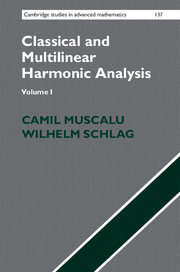Book contents
- Frontmatter
- Contents
- Preface
- Acknowledgements
- 1 Fourier series: convergence and summability
- 2 Harmonic functions; Poisson kernel
- 3 Conjugate harmonic functions; Hilbert transform
- 4 The Fourier transform on ℝd and on LCA groups
- 5 Introduction to probability theory
- 6 Fourier series and randomness
- 7 Calderón–Zygmund theory of singular integrals
- 8 Littlewood–Paley theory
- 9 Almost orthogonality
- 10 The uncertainty principle
- 11 Fourier restriction and applications
- 12 Introduction to the Weyl calculus
- References
- Index
Preface
Published online by Cambridge University Press: 05 February 2013
- Frontmatter
- Contents
- Preface
- Acknowledgements
- 1 Fourier series: convergence and summability
- 2 Harmonic functions; Poisson kernel
- 3 Conjugate harmonic functions; Hilbert transform
- 4 The Fourier transform on ℝd and on LCA groups
- 5 Introduction to probability theory
- 6 Fourier series and randomness
- 7 Calderón–Zygmund theory of singular integrals
- 8 Littlewood–Paley theory
- 9 Almost orthogonality
- 10 The uncertainty principle
- 11 Fourier restriction and applications
- 12 Introduction to the Weyl calculus
- References
- Index
Summary
Harmonic analysis is an old subject. It originated with the ideas of Fourier in the early nineteenth century (which were preceded by work of Euler, Bernoulli, and others). These ideas were revolutionary at the time and could not be understood by means of the mathematics available to Fourier and his contemporaries. However, it was clear even then that the idea of representing any function as a superposition of elementary harmonics (sine and cosine) from an arithmetic sequence of frequencies had important applications to the partial differential equations of physics that were being investigated at the time, such as the heat and wave equations. In fact, it was precisely the desire to solve these equations that led to this bold idea in the first place.
Research into the precise mathematical meaning of such Fourier series consumed the efforts of many mathematicians during the entire nineteenth century as well as much of the twentieth century. Many ideas that took their beginnings and motivations from Fourier series research became disciplines in their own right. Set theory (Cantor) and measure theory (Lebesgue) are clear examples, but others, such as functional analysis (Hilbert and Banach spaces), the spectral theory of operators, and the theory of compact and locally compact groups and their representations, all exhibit clear and immediate connections with Fourier series and integrals. Furthermore, soon after Fourier proposed representing every function on a compact interval as a trigonometric series, his idea was generalized by Sturm and Liouville to expansions with respect to the eigenfunctions of very general second-order differential operators subject to natural boundary conditions – a groundbreaking result in its own right.
- Type
- Chapter
- Information
- Classical and Multilinear Harmonic Analysis , pp. ix - xviPublisher: Cambridge University PressPrint publication year: 2013



